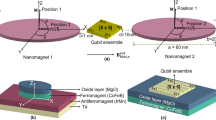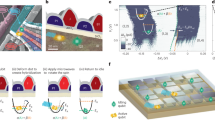Abstract
The spin of a single electron subject to a static magnetic field provides a natural two-level system that is suitable for use as a quantum bit, the fundamental logical unit in a quantum computer1,2,3. Semiconductor quantum dots fabricated by strain driven self-assembly4 are particularly attractive for the realization of spin quantum bits, as they can be controllably positioned5, electronically coupled6 and embedded into active devices7,8,9,10. It has been predicted that the atomic-like electronic structure4 of such quantum dots suppresses coupling of the spin to the solid-state quantum dot environment11,12,13,14, thus protecting the ‘spin’ quantum information against decoherence15,16. Here we demonstrate a single electron spin memory device in which the electron spin can be programmed by frequency selective optical excitation. We use the device to prepare single electron spins in semiconductor quantum dots with a well defined orientation, and directly measure the intrinsic spin flip time and its dependence on magnetic field. A very long spin lifetime is obtained, with a lower limit of about 20 milliseconds at a magnetic field of 4 tesla and at 1 kelvin.
This is a preview of subscription content, access via your institution
Access options
Subscribe to this journal
Receive 51 print issues and online access
$199.00 per year
only $3.90 per issue
Buy this article
- Purchase on Springer Link
- Instant access to full article PDF
Prices may be subject to local taxes which are calculated during checkout




Similar content being viewed by others
References
Loss, D. & DiVincenzo, D. Quantum computation with quantum dots. Phys. Rev. A 57, 120–126 (1998)
Kane, B. E. A silicon-based nuclear spin quantum computer. Nature 393, 119–120 (1998)
Elzerman, J. M. et al. Single-shot read-out of an individual electron spin in a quantum dot. Nature 430, 431–435 (2004)
Arakawa, Y. & Tarucha, S. (eds) Proc. 2nd Int. Conf. on Semiconductor Quantum Dots (QD 2002), Physica Status Solidi B 238 229–372, (2003)
Heidemeyer, H., Denker, U., Müller, C. & Schmidt, O. G. Morphology response to strain field interferences in stacks of highly ordered quantum dot arrays. Phys. Rev. Lett. 91, 196103 (2003)
Bayer, M. et al. Coupling and entangling of quantum states in quantum dot molecules. Science 291, 451–453 (2001)
Zrenner, A. et al. Coherent properties of a two-level system based on a quantum-dot photodiode. Nature 418, 612–614 (2002)
Oulton, R. et al. Manipulation of the homogeneous linewidth of an individual In(Ga)As quantum dot. Phys. Rev. B 66, 045313 (2002)
Hanson, R., Witkamp, B., Vandersypen, L. M. K., Willems van Beveren, L. H. & Elzerman, J. M. Zeeman energy and spin relaxation in a one-electron quantum dot. Phys. Rev. Lett. 91, 196802 (2002)
Fujisawa, T., Austing, D. G., Tokura, Y., Hirayama, Y. & Tarucha, S. Nonequilibrium transport through a vertical quantum dot in the absence of spin-flip energy relaxation. Phys. Rev. Lett. 88, 236802 (2002); Allowed and forbidden transitions in artificial hydrogen and helium atoms. Nature 419, 278 (2002)
Meier, F. & Zakharchenya, B. (eds) Modern Problems in Condensed Matter Sciences Vol. 8, Optical Orientation (North Holland, Amsterdam, 1984)
Khaetskii, A. V. & Nazarov, Y. V. Spin relaxation in semiconductor quantum dots. Phys. Rev. B 61, 12639–12642 (2000)
Khaetskii, A. V. & Nazarov, Y. V. Spin flip transitions between Zeeman sublevels in semiconductor quantum dots. Phys. Rev. B 64, 125316 (2001)
Woods, L. M., Reinecke, T. L. & Lyanda-Geller, Y. Spin relaxation in quantum dots. Phys. Rev. B 66, 161318 (2002)
Gupta, J. A., Awschalom, D. D., Peng, X. & Alivisatos, A. P. Spin coherence in semiconductor quantum dots. Phys. Rev. B 59, R10421–R10424 (1999)
Golovach, V. N., Khaetskii, A. V. & Loss, D. Phonon induced decay of the electron spin in quantum dots. Phys. Rev. Lett. 93, 016601 (2004)
Kroutvar, M. et al. Wavelength selective charge storage in self-assembled InGaAs/GaAs quantum dots. Appl. Phys. Lett. 83, 443–445 (2003)
Finley, J. J. et al. Electrical detection of optically induced charge storage in self-assembled InAs quantum dots. Appl. Phys. Lett. 73, 2618–2620 (1998)
Finley, J. J. et al. Charged and neutral exciton complexes in individual self-assembled In(Ga)As quantum dots. Phys. Rev. B 63, 073307 (2001)
Bayer, M. et al. Fine structure of neutral and charged excitons in self-assembled In(Ga)As/(Al)GaAs quantum dots. Phys. Rev. B 65, 195315 (2002)
Langbein, W. et al. Control of fine-structure splitting and biexciton binding in InxGa1–xAs quantum dots by annealing. Phys. Rev. B 69, 161301 (2004)
Oulton, R. et al. Continuum transitions and phonon coupling in single self-assembled Stranski-Krastanow quantum dots. Phys. Rev. B 68, 235301 (2003)
Khaetskii, A. V., Loss, D. & Glazman, L. Electron spin evolution induced by interaction with nuclei in a quantum dot. Phys. Rev. B 67, 195329 (2003)
Acknowledgements
We thank V. Golovach and D. Loss for discussions. We also thank the DFG for financial support and Attocube GmbH for technical support.
Author information
Authors and Affiliations
Corresponding author
Ethics declarations
Competing interests
The authors declare that they have no competing financial interests.
Supplementary information
Rights and permissions
About this article
Cite this article
Kroutvar, M., Ducommun, Y., Heiss, D. et al. Optically programmable electron spin memory using semiconductor quantum dots. Nature 432, 81–84 (2004). https://doi.org/10.1038/nature03008
Received:
Accepted:
Issue Date:
DOI: https://doi.org/10.1038/nature03008
This article is cited by
-
Room-temperature coherent optical manipulation of hole spins in solution-grown perovskite quantum dots
Nature Nanotechnology (2023)
-
Nuclear spin diffusion in the central spin system of a GaAs/AlGaAs quantum dot
Nature Communications (2023)
-
Complete and fidelity-robust hyperentangled-state analysis of photon systems with single-sided quantum-dot-cavity systems under the balance condition
Quantum Information Processing (2023)
-
Perspective: nanoscale electric sensing and imaging based on quantum sensors
Quantum Frontiers (2023)
-
Electrical switching of spin-polarized current in multiferroic tunneling junctions
npj Computational Materials (2022)
Comments
By submitting a comment you agree to abide by our Terms and Community Guidelines. If you find something abusive or that does not comply with our terms or guidelines please flag it as inappropriate.



